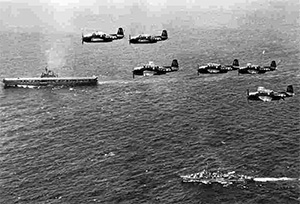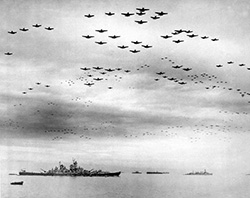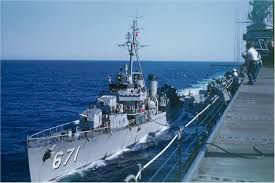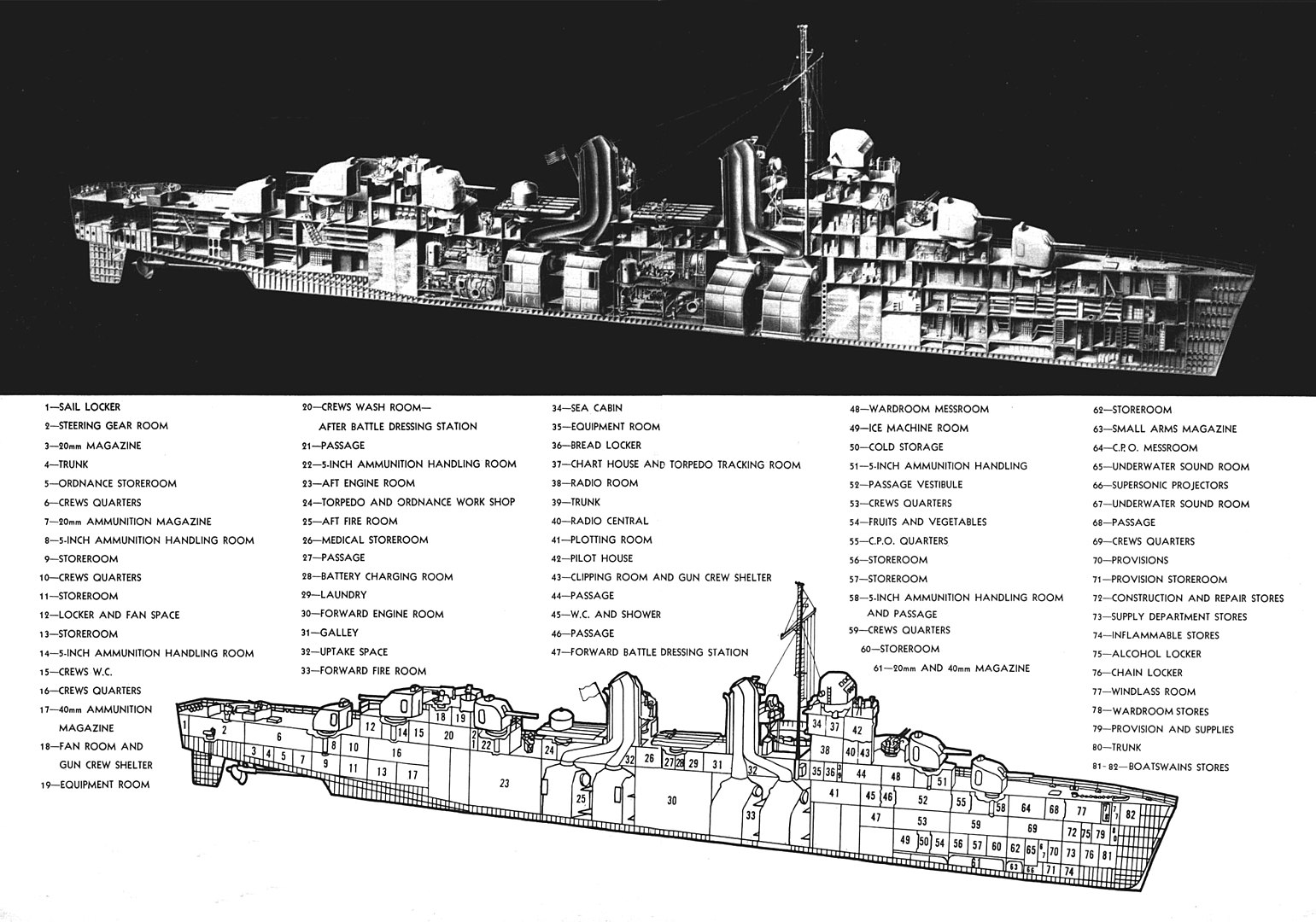U.S.S. GATLING

In 1988, Dad sat down to help out John Newton, an old shipmate from the U.S.S. Gatling, who was writing a history of the ship. Collecting his memorabilia and memories Dad recorded a series of cassette tapes to document as many of his experiences on board the "Gat" as he could. The contents of those tapes are transcribed below.
Note that since Dad was addressing these tapes to a shipmate who presumably knew the Gatling as well as Dad did, there are numerous terms and references that were not clear to me. To help with this situation I have relied on Wikipedia for some background information on the U.S.S. Gatling specifically and a diagram of the Fletcher-class destroyer of which it was a member.
Phil was able to get the cassette tapes converted to CD and I was able to extract the individual memories that Dad recorded. In the process we may have lost a bit of the continuity of the narrative, but I think we captured the majority of what he wanted to tell John Newton. Note that Dad didn't title each segment and I did so simply to reflect the highlights of that particular episode.
I have had to do some gentle editing of the transcription. Speaking into a tape recorder is a bit different than writing and the transcription showed a lot of restarted thoughts and run-on sentences which I have tried to minimize.
Also, just in case you weren’t aware, the U.S.S. Gatling (DD671) like all destroyers in WWII was generally referred to as a "tin can" or "can". The web site "NavyForMoms.com" offers the following etymology of the term:
Tincan – Also seen as "Tin Can," a common nickname for a destroyer. The nickname arose because in World Wars One and Two, the hull plating of this ship type was so thin the sailors claimed they were made from tin cans. In fact, a .45 pistol bullet would penetrate it. Modern destroyers have much thicker hull plating, but the nickname persists.
The Gatling has its own website at www.destroyers.org/uss-gatling/ but I was unable to find any record of John Newton’s book.
A vessel draws life from the spirit of her crew, which derives in large part from the leadership qualities of her chiefs and officers. Morale defies quantification – and yet it weighs significantly on the ultimate lethality of the tools of war. A ship’s effectiveness is the product of thousands of bonds that develop between individual officers and crew. The bonds form and break in a chain reaction, the power of which is determined by drill, by relationships, by fortitude, faith, and values. Task force commanders can be only abstractly aware of these uncountable qualities as they exist on the particular ships under their command. The officers of the ships themselves see these qualities more clearly but still can only guess how the chemical reactions will coalesce when the real shooting starts and men begin to die.
The Last Stand of the Tin Can Sailors by James D. Hornfischer
The keel of the Gatling was laid down 3 March 1943 by the Federal Shipbuilding and Drydock Company, Kearny, New Jersey; launched 20 June 1943; sponsored by Mrs. John W. Gatling, wife of the inventor's grandson; and commissioned 19 August 1943 at New York Navy Yard, Lieutenant Commander Alvin H. Richardson in command.
After shakedown out of Bermuda and alteration at New York early November, the new destroyer called at Norfolk, Virginia, to conduct training cruises for crews of destroyers still under construction. On 19 November 1943 Gatling proceeded to Trinidad, British West Indies, to escort aircraft carrier Langley to Norfolk. Gatling stood out from Norfolk 3 December, escorting Intrepid through the Panama Canal to San Francisco, California, arriving 22 December. The next day she sailed for Pearl Harbor.
1944

On 16 January 1944 Gatling sortied with the Fast Carrier Task Force (then Fifth Fleet's TF 58, also known as Third Fleet's TF 38) to support the forthcoming invasion of the Marshall Islands; thereafter, Gatling was continuously with the carrier task forces as they struck Japanese outposts and finally hit the heart of Japan itself.
In February the first carrier strikes against Truk occurred. Gatling provided fire support during the raid and screened the flattops during raids on the Marianas a few days later. In March she joined in the attack on Emirau Island and at the beginning of April in the air strikes against the Palau Archipelago. Steaming south to strike Hollandia, Wakde, Sawar, and Same, New Guinea, the task force supported Army landings at Aitape, Tanahmerah Bay, and Humboldt Bay from 21 to 26 April. During this action, Gatling stood radar picket duty and directed fighter planes. After new attacks on Truk late April 1944, Gatling supported the invasion and occupation of the Marianas from 10 June to 5 July. In the Battle of the Philippine Sea, 19 and 20 July, Gatling was credited with shooting down or aiding in the destruction of six Japanese planes.
Late that month, carrier task forces again struck the Palaus and blasted Yap and Ulithi. In early August the Bonin Islands became targets for Gatling guns, and in September the carriers she guarded repeatedly struck Japanese targets in the Philippines.
October saw attacks against Okinawa beginning on 10 October and against Formosa, Luzon, and the Visayas from ll-23 October. On 24 October, after enemy bombs had sunk the light aircraft carrier Princeton in the Battle of the Sibuyan Sea, Gatling rescued over 300 of the vessel's survivors. For heroism in saving these men, four Gatling crewmen were awarded the Navy and Marine Corps Medal, and 16 others received the Bronze Star.
Gatling landed the survivors at Ulithi and rejoined the carrier task force for November and December strikes against the Philippines. After powerful Typhoon Cobra, in which three destroyers capsized, Gatling searched for survivors and helped to save over 100 men from the sea.
1945
At Christmas 1944, the destroyer returned to Ulithi. The task force sortied 29 December to strike Formosa and Luzon during January 1945. Hoping to locate and destroy a Japanese fleet in that area, Admiral William Halsey took the task force into the South China Sea 10 January and hit targets in Indochina and on the China coast.
In the middle of February, the carriers launched initial attacks against Honshū with Tokyo as their main target. As part of a picket line over 30 miles in advance of the main forces, Gatling was once within 40 miles (64 km) of Honshū. On 19 and 20 February, as part of Destroyer Division 99 (DesDiv 99), she escorted North Carolina and Indianapolis to Iwo Jima to support the gallant Marines who were fighting to wrest that volcanic fortress from Japan to become a base for B-29s damaged over the home islands. Rejoining the carrier task force, Gatling aided in new strikes against Honshū and Okinawa in late February and early March. She returned to Iwo Jima independently and throughout March blasted Japanese shore batteries to support the invasion. During this duty, the versatile and busy destroyer saved the entire crew of a B-29 bomber forced down while returning from a mission against Nagoya.
On 29 March 1945, she stood out from Iwo Jima, escorting transports carrying victorious marines to Guam. The destroyer then sailed to the United States for well-earned overhaul and repairs, arriving San Francisco 18 April.

After repairs and refresher training, Gatling escorted New Jersey and Biloxi to Eniwetok, bombarding Wake Island en route. Continuing to escort New Jersey, she arrived at Guam 9 August. There the news came that Japan had accepted the provisions of the Potsdam Declaration and agreed to surrender. Gatling now headed for Japan escorting transports bearing the 4th Marine Division as the 3d Fleet rendezvoused off Japan. On 3 September 1945, Gatling steamed into Tokyo Bay as a unit of the Allied Naval Occupation Forces of Japan.
During her aggressive career in World War II, Gatling traveled over 175,000 miles (282,000 km) and fired 77 tons of high explosives from her guns. She sank two enemy ships and splashed eight Japanese planes, either as kills or assists. In addition to her other rescue missions, preserving the lives of over 400 sailors, she saved 37 aviators forced to ditch at sea. Finally, these heroic exploits through two busy battle-filled years were accomplished without the loss of a single man from enemy action, sickness, or accident.
Gatling decommissioned 16 July 1946 and entered the Atlantic Reserve Fleet at Charleston, South Carolina. Gatling, after distinguished service in war and peace, was stricken from the Naval Vessel Register 1 December 1974, sold 22 February 1977 and broken up for scrap. Gatling received eight battle stars for World War II service and one battle star for Korean War service.
from wikipedia.org
FLETCHER-CLASS DESTROYER
The Fletcher class was a class of destroyers built by the United States during World War II. The class was designed in 1939, as a result of dissatisfaction with the earlier destroyer leader types of the Porter and Somers classes. Some went on to serve during the Korean War and into the Vietnam War.

The United States Navy commissioned 175 Fletcher-class destroyers between 1942 and 1944, more than any other destroyer class, and the design was generally regarded as highly successful. Fletchers had a design speed of 38 knots and an armament of five 5" guns in single mounts with 10 21" torpedoes in two quintuple centerline mounts.
The long-range Fletcher-class ships performed every task asked of a destroyer, from antisubmarine warfare and anti-aircraft warfare to surface action. They could cover the vast distances required by fleet actions in the Pacific and served almost exclusively in the Pacific Theater of Operations during World War II, during which they accounted for 29 Imperial Japanese Navy submarines sunk.
In a massive effort, the Fletchers were built by shipyards across the United States and, after World War II ended, 11 were sold to countries that they had been built to fight against: Italy, Germany, and Japan, as well as other countries, where they had even longer, distinguished careers. Three have been preserved as museum ships in the U.S. and one in Greece.
| Class and type: | Fletcher-class destroyer |
| Displacement: | 2,050 tons |
| Length: | 376 ft 5 in (114.73 m) |
| Beam: | 39 ft 7 in (12.07 m) |
| Draft: | 17 ft 9 in (5.41 m) |
| Propulsion: | 60,000 shp (45,000 kW); geared turbines; 2 propellers |
| Speed: | 35 knots (65 km/h; 40 mph) |
| Range: | 6,500 nautical miles (12,000 km; 7,500 mi) at 15 kn (28 km/h; 17 mph) |
| Complement: | 329 officers and enlisted |
| Armament: |
|
from wikipedia.org
Fletcher-class tin cans were deep-sea thoroughbreds, members of the finest class of U.S. destroyers produced during World War II.
By 1944 the Fletcher-class destroyers…represented the state of the art. They were the first class of U.S. warship to be designed free of treaty limitations. Because their design coincided with the massive ramp-up in production during the early years of the war, more Fletchers were produced than any other class of combatant vessel. From the February 1942 launching of the Nicholas at Bath Iron Works in Maine to the June 1944 Rooks at Seattle-Tacoma, 175 Fletcher-class destroyers would be built by the World War II ended. Most of them served in the Pacific. Because the absence of treaty restraint enabled the Navy’s General Board to tailor the new destroyers to their mission rather than to the requirements of diplomats, the Fletchers were large ships. Over-stretching a football field at 376 1/2 feet in length, they were far more imposing than the nickname "tin cans" might have suggested. It would have taken Ted William’s best swing to hit a baseball from Fletcher’s fantail all the way to its graceful bow. With a displacement of 2,050 tons (2,700 with a full fuel load), they were swift, seaworthy, and stout, with considerable firepower. Though rated at a top speed of thirty-six knots, the Fletchers carried enough weaponry to make the biggest enemy feel their punch – ten Mark 15 torpedoes, five single-mounted five-inch/38-caliber guns, a formidable thicket of twenty- and forty-millimeter machine guns, two roller racks of depth charges, and the sophisticated sensing equipment to land them on their targets.
The Last Stand of the Tin Can Sailors by James D. Hornfischer
Two of the Fletcher’s systems would prove to be decisive in sea battles against the Imperial Japanese Navy (IJN) – radar and the gun fire-control-system (GFCS). Although radar technology had been demonstrated as early as December 1934, it wasn’t until war became a distinct possibility that the US recognized its potential and began developing ship- and land-based systems. The first of these systems were implemented in the early 1940 for the US Navy which also coined the acronym RADAR which stood for RAdio Detection And Ranging. In 1940 Great Britain, recognizing that the manufacturing capacities of the US were a key to success in the war, shared a more powerful radar version with the US fostering the development of even more capable radars by Bell Labs, MIT and other research facilities.
The gun fire-control system (GFCS) on the Gatling was the Ford Mark 1, later 1A, Fire Control Computer, which was an electro-mechanical analog ballistic computer that provided accurate firing solutions and could automatically control its 5-inch guns against surface ships, aircraft, and shore targets, with radar sighting. The major components of the GFCS are a human-controlled director, radar, gyro, and other equipment connecting the plotting room with the gun mounts.
The data passed down into the ship’s Mark 1A fire-control computer. Developed by the Ford Instrument Company in the 1930’s, the intricate but sturdy array of gears, cams, shafts, and dials was an analog device with no memory as we understand it today. Rather, it was designed only to predict the position of its target and align each of the five turrets to lace its shell at the coordinates that the computer calculated the target would occupy at impact. Just as a football quarterback pedaling back in the pocket must place extra zip on his throw to compensate for his own rearward movement, the computer removed the imparted effect of the ship’s own motion from the firing solution. A gyroscopic stable element corrected for the pitching and rolling of the ship’s five -inch shells – adjusted for bore wear and current weather conditions; the ship’s current latitude and the relation of its heading to true magnetic north, in order to compensate for the effect of the earth’s rotation and the "EnglishQuot; that it imparted to the shell’s trajectory; and the range to the target, which amplified the effect of all the variables. The computer took about thirty seconds to calculate a firing solution for a new target. … The computer transmitted electrical signals to the turret motors to air the guns accordingly.
The Last Stand of the Tin Can Sailors by James D. Hornfischer
In contrast to US radar aided system, the IJN relied on optical rangefinders, lacked gyros to sense the horizon, and required manual handling of guns and the follow-up shots. The US technological advantage undoubtedly played a role in the IJN battleships' dismal performance in the Battle off Samar on October 25, 1944. The sea battle was the largest of the war in the Pacific and resulted in a resounding defeat for the IJN.
In that action, American destroyers pitted against the world's largest armored battleships and cruisers dodged shells for long enough to close to within torpedo firing range, while lobbing hundreds of accurate automatically aimed 5-inch rounds on target. IJN cruisers did not land hits on US escort carriers until after an hour of pursuit had reduced the range to 5 miles. The October 24th Battle of the Surigao Strait had already established the clear superiority of US radar-assisted systems at night.
It does need to be noted, however, that all analog anti-aircraft fire control systems had severe limitations and even the most advanced US system required nearly 1000 rounds of 5" ammunition per kill, even in late 1944. Digital computers would not be integrated into GFCS’s until the mid-1970s.

image from wikipedia.org
